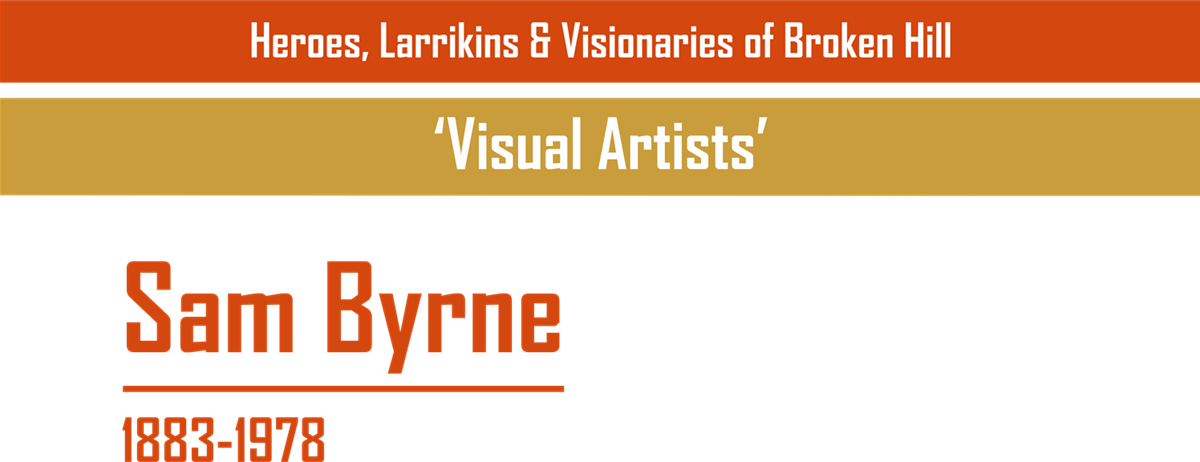Sam Byrne

Michael Eldridge Samuel [Sam] Byrne was an early naive painter and miner who grew up in Broken Hill and whose art was an expression and record of his life as an underground miner. His later paintings are social commentary as much as observations and humorous anecdotes. They capture dust storms engulfing Afghan cameleers, and desert floods stranding rabbits and goats – introduced species that wreaked environmental havoc – while native animals roamed freely. He painted miners being blown apart by underground explosions, and scenes from the miners’ strikes of the late nineteenth and early twentieth century, and the hardships and challenges of living and working in the outback and in the mines. Byrne called himself a socialist, and his political ideology is reflected in his paintings.
Sam Byrne was born in the Barossa Valley, South Australia, to an Irish father and Australian mother: James and Elizabeth Byrne. James was an itinerant worker, always looking for the next way to make his fortune, which brought the family to the Barrier district in 1885. James worked as a blacksmith on the Daydream and Umberumberka mines before moving the family to Thackaringa, a small silver mining settlement west of Broken Hill. When James died in 1890, Elizabeth moved her four small boys to Broken Hill and tried to make ends meet working as a washerwoman. The family lived in hardship: in a hut made from canvas with no heating or sanitation. Aged nine, Sam experienced the 1982 Big Strike. When ‘scab’ or non-union labour was brought in by mine managers to replace striking workers, Sam and his friends at the Central Primary School would throw rocks at the scabs’ houses and play pranks on mining officials.
Elizabeth Byrne died of pneumonia while Sam was still young. He and his brothers were taken in by two aunts and an uncle who soon disappeared to the Victorian gold fields. When he was old enough, Sam began selling the local union paper, the Barrier Miner, and collecting rabbit carcasses to earn a few pennies. At fifteen he started working at the BHP Big Mine. The work was punishing, and inspired Sam Byrnes’ ideological and artistic voice. The mines were dangerous and toxic: underground fires and explosions, lead poisoning and lethal machinery. He was unemployed for a year after a machine accident badly injured his arm. After the accident he trained to be an engine driver above ground.
Throughout his mining career, Sam Byrne was sketching onto whatever surfaces were available: often on the timbers in underground mines. These drawings were his mementos, and it wasn’t until he retired in the 1950s that he started painting in earnest, inspired by an exhibition of modernist paintings. He believed he could do better. He submitted paintings for competitions: first water colours on paper then oils and gloss enamels on masonite. He came under the guidance of Florence May Harding, another talented Broken Hill painter and an art teacher at the Technical College. May Harding herself is considered to be instrumental in turning Broken Hill into the home of outback art. Championed by Harding and well-known Melbourne artist Leonard French, Sam Byrne started exhibiting commercially and, slowly, gained recognition. His work ultimately attracted both private and corporate buyers.
At home in Broken Hill he became an active member of the newly formed Willyama Art Society along with Florence May Harding and the five painters who became known as the Brushmen of the Bush. He was environmentally as well as socially conscious and took trips into the desert with the Barrier Field Naturalists and was a member of the Broken Hill Historical Society. He has been called a folk historian as well as a naive painter.
In 1977, the year before he died, a Sam Byrne landscape was a finalist in the Art Gallery of New South Wales Wynne Prize for landscape painting. The painting was of the BHP mine and smelters, and it was purchased for BHP to hang in their Melbourne offices. A fitting tribute to a man who, as a boy, threw pebbles at passing mine officials.
Audio transcript available.
PICK UP YOUR FREE BROCHURE & MAP OF THIS TRAIL FROM THE VISITOR INFORMATION CENTRE